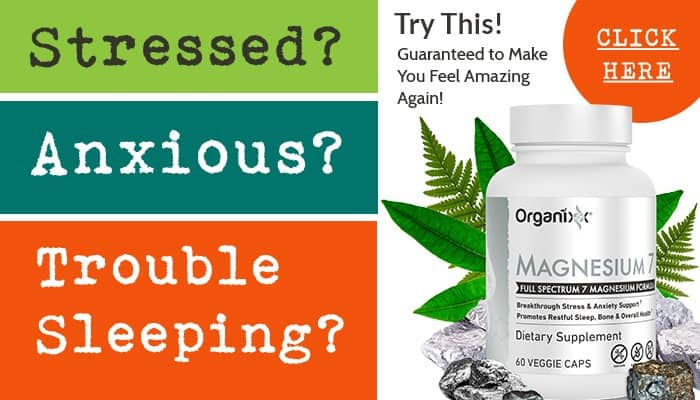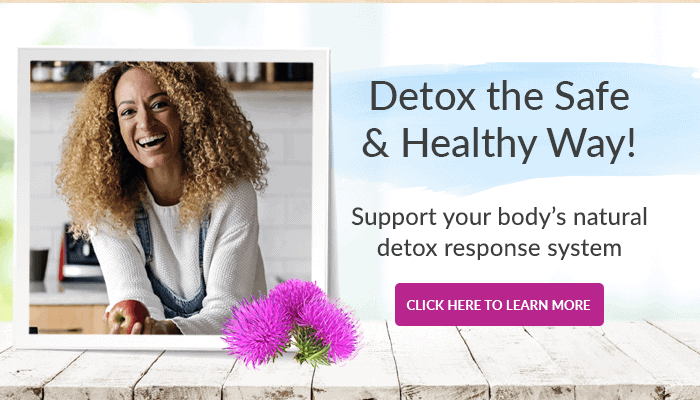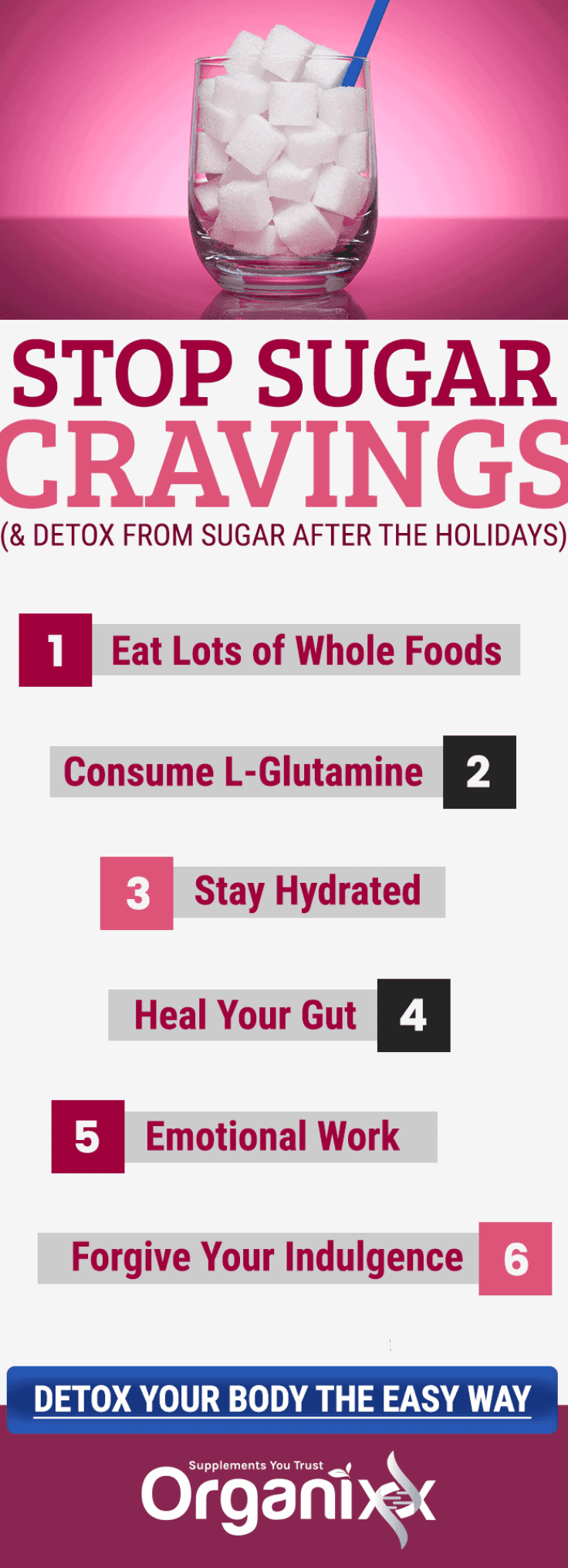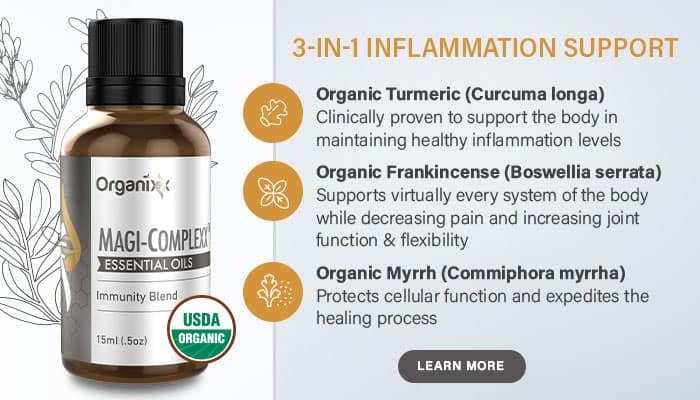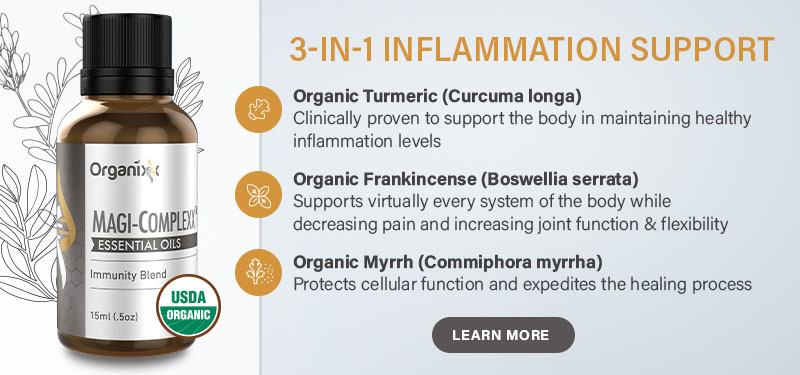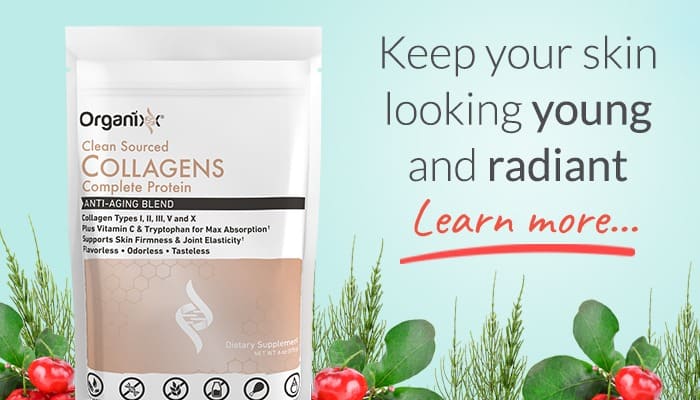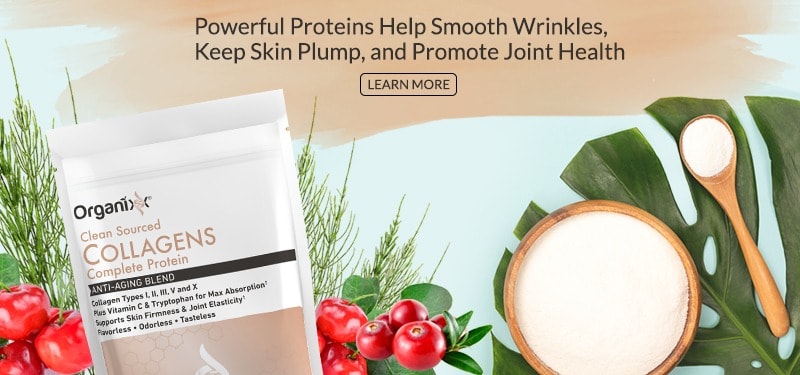We all get stressed out occasionally and our body is designed to deal with it… occasionally. When stress becomes chronic, however, that is when trouble begins. In this article, you’ll learn helpful ways to deal with stress so you can remain healthy and happy throughout the year.
Understanding the Stress Response (Fight or Flight)
When a person is in crisis, the body responds immediately and begins preparation for survival. This is called the “fight or flight” response and here is how it works:
- Stimuli reach the amygdala and eventually the hypothalamus in the brain, which controls hormone production throughout the entire body.
- The central nervous system (CNS) and in particular the sympathetic nervous system kicks in and adrenaline is released.
- At the beckoning of CNS signals, the hypothalamus produces a corticotropin-releasing hormone, which eventually stimulates the production of the stress hormone cortisol.
- Another word for adrenaline is epinephrine. Cortisol, epinephrine (i.e., adrenaline), and other stress hormones enter into the bloodstream and make their way throughout the body.
- Every tissue in the body is covered with what are called “glucocorticoid receptors.” These are proteins that allow cortisol to engage with the organs so they can prepare for “fight or flight.” When cortisol hormones fit into these receptors, the body is ready to do all it can to survive.
Finally, changes take place in the body and the brain. Sensations such as heightened senses and a pounding heart are both indications that the sympathetic nervous system has been activated. - Changes also occur that you may not be aware of. This includes blood being diverted to the extremities, changes in cognitive functioning, digestive processes grinding to a halt, and immune system functions slowing or stopping. Inflammatory markers, such as C-reactive protein, are heightened as well.
The 411 About Stress and Disease
It is safe to say that the U.S. population as a whole gets stressed big time when the holiday season rolls around.

According to a 2015 Health Line survey, 65% of Americans feel some kind of stress during the period between Thanksgiving and New Years. A 2017 Harris Poll found that 70% of people would even give up holiday gift-giving if they could!
For most, the stress caused by the holidays does not occur because of a single traumatic event but by an overbooked schedule, financial pressures, and a diet high in sugar and fat.
During the holidays, most Americans feel more severely what we all face throughout the rest of the year: chronic stress. As you learn more about the correlation of stress and disease below, you can begin to develop strategies for combatting a high-stress lifestyle all year long.
Not All Stress Is Bad Stress
It’s important to remember that not all stress is bad. The body’s stress responses are normal and could potentially save your life. It’s when the cycle of fight or flight continues for a long period of time, even at a low level, that it can lead to disease. The toll that chronic stress takes on your body is called the allostatic load.
Here are just a few changes that may occur in your body as your allostatic load increases:
- The immune system is compromised. Immune system cell production is lowered during times of stress. After all, how is the body expected to heal and repair itself when it is actively dealing with crisis?
- Glucose levels increase. The body needs fuel to get your arms and legs pumping in prep for survival. While glucose levels increase, adrenaline levels often taper off and become depleted over time. Adrenal fatigue is a condition that affects up to 80% of the American population, according to some studies.
- Fungal growth increases. Fungal growth loves glucose and the acidic environment that too much of it can create in the body. This vicious cycle also increases the risk for major disease. Cognitive function becomes impaired. Neurotransmitters and neuropeptides can be affected when stress occurs. Researchers say that these neurological stress responses are all “fine-tuned responses to diverse challenges.” However, according to a 2014 study conducted by Arizona State University, chronic stress can significantly impair spatial learning and memory function.
- The body wants to put on weight. Finally, being stressed all the time can encourage your body to put on weight. This is because of changes in metabolism and glucose that take place with chronic stress, according to an Obesity journal study.
The Relaxation Response: 7 Ways to Deal with Stress
The flip side of the “flight or fight” response is the “relaxation response,” which is run by the parasympathetic nervous system.
While chronic stress can lead to more and more disease conditions over time, the relaxation response can lead to more repairing and healing.
The relaxation response puts the limbic system to sleep and allows all of the healing mechanisms in the gut, immune system, and other areas to do their job.
This can lead to:
- An increase in the production of “healing hormones” including endorphins, oxytocin, serotonin, and dopamine, which all play key roles in healthy immune system function (plus, they make you feel really good!)
- A decrease in cortisol and adrenaline, which in turn lowers inflammatory markers in the body
- An increase in immune system cells, including natural killer (NK) cells
- An increase in cognitive ability and memory
- An increase in the function of detoxification pathways, such as the liver
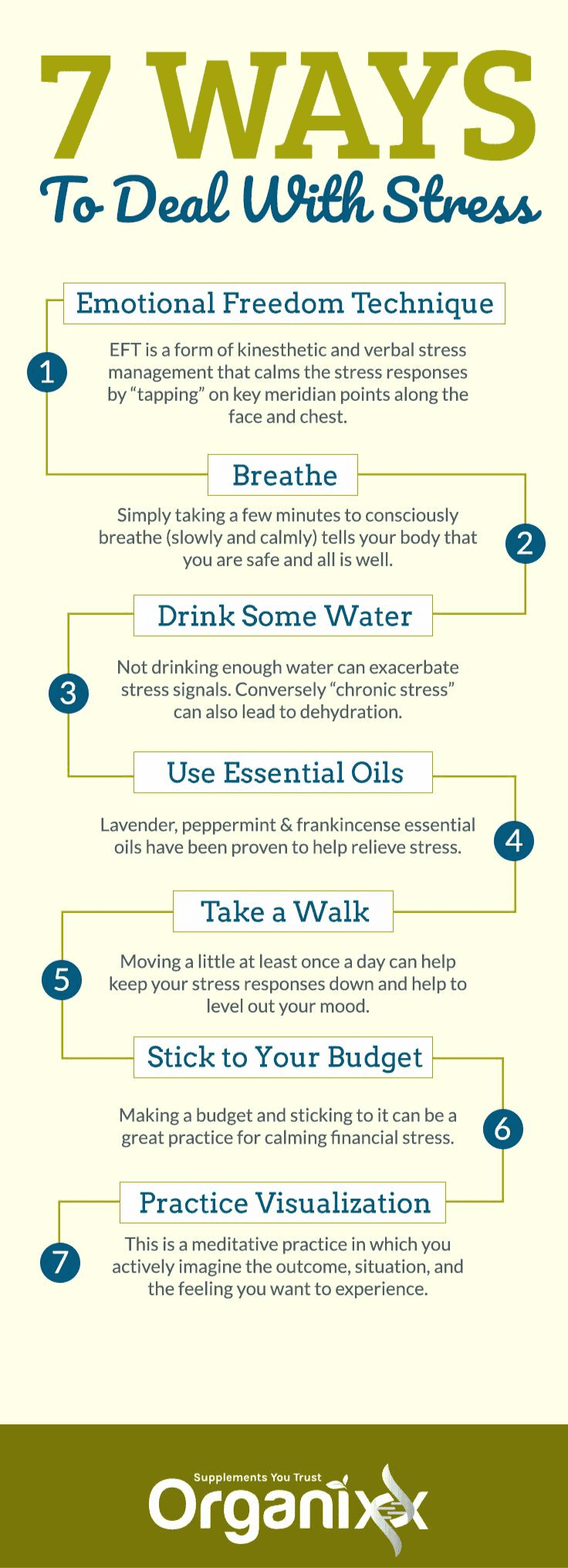
The more a person remains in “relaxation mode,” the lower the risk for disease and the longer the life expectancy.
Studies have shown that symptoms of insomnia, anxiety/depression, digestive conditions, and even arthritis and cancer all decrease the more the body remains within the perimeters of the relaxation response.
If the relaxation response is such a great thing, then how can we get there and stay there as we enter the New Year?
The relaxation response can only kick in when a person feels safe, supported, and balanced. To get here, you must learn the tools that will become a part of your everyday life.
 Here are a few quick, easy tips you can use when you are in the “thick of it” as well as a few techniques to cultivate the relaxation response over time:
Here are a few quick, easy tips you can use when you are in the “thick of it” as well as a few techniques to cultivate the relaxation response over time:
#1: EFT.
EFT stands for Emotional Freedom Technique and is also known as “tapping.” Tapping has been shown to drastically reduce stress responses in a very short amount of time. It is a form of kinesthetic and verbal stress management that calms the stress responses by “tapping” on key meridian points along the face and chest.
#2: Breathe.
Many studies have shown that deep breathing can calm the nervous system within minutes. Think about the last time you were really stressed out. Was your breathing shallow or long and slow? Were you holding your breath without realizing it? Simply taking a few minutes to consciously breathe (slowly and calmly) tells your body that you are safe and all is well.
#3: Drink Some Water.
Dehydration can be part of the vicious cycle that occurs with chronic stress. While not drinking enough water can exacerbate stress signals, being in “chronic stress” mode can also lead to dehydration, say experts.
#4: Let Essential Oils Help You.
Lavender, peppermint, and frankincense are all amazingly effective essential oils that have been proven to help relieve stress. Lavender oil can help calm the nervous system. Peppermint can stimulate balanced energy, especially if rubbed on the temples or the back of the neck using a carrier oil like jojoba. Finally, frankincense essential oil can help to support healthy inflammation levels as well as help you to “center.” (You can find ways to use these essential oils and more here.)
#5: Take a Walk.
Getting your body moving even just a little at least once a day can help keep your stress responses down and help to level out your mood. A study at Uniformed Services University of Health Sciences in Bethesda, Maryland, found that regular exercise helped even out depression and fatigue for participants after just one week.
#6: Stick to Your Budget.
Making a budget and sticking to it can be a great practice for calming financial stress which, according to the Health Line study, is the leading cause of overall holiday stress. While you may have overspent during the holidays, take some time now to ensure your budget is realistic for you.
#7: Practice Visualization.
Visualization is a meditative practice in which you actively imagine the outcome, situation, and, most importantly, the feeling you want to experience. It might sound a bit woo-woo but evidence-based research around visualization says that it works when done correctly.
A 2008 trial by the University of South Florida College of Nursing found that relaxation techniques in conjunction with guided imagery (or visualization) with breast cancer patients led to higher natural killer cell activity after surgery.
Give yourself the gift of self-nurturing and healing this year by purposely engaging in activities that can help your body turn on the relaxation response instead of the stress response.
The power of the body to heal when it is in this state is clear. In fact, according to Dr. Herbert Benson, the cardiologist who first coined the term, eliciting the relaxation response may even help the body move towards balance on the genetic level.
Magnesium deficiency is linked to stress, diabetes, heart disease, osteoporosis, chronic fatigue syndrome, depression, anxiety, trouble sleeping, sore muscles, migraines, and many more debilitating health conditions.
If your body needs magnesium, you want the most beneficial kind your body can actually absorb. Organixx Magnesium 7 gives you seven (7) of the very best, most bioavailable types of elemental magnesium available.
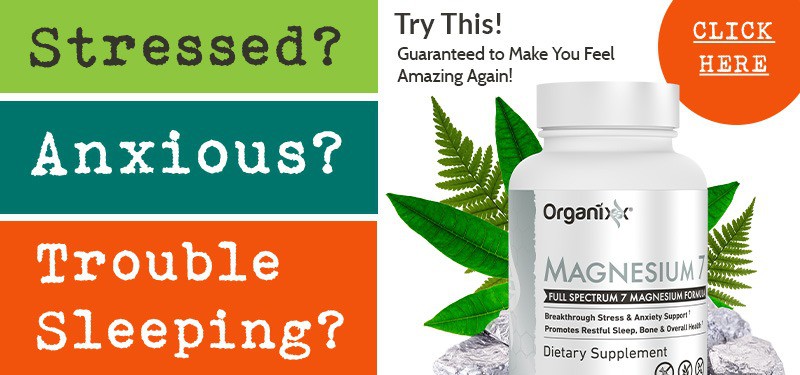
Want to maintain that positive mood, keep your energy levels high, and just feel GREAT every day? Achieve all of this and more with your next liver detox!
Why would detoxing the liver naturally have such a profound effect on your body, mind, energy level, and overall health? Read on to discover the reasons why.
What Does Your Liver Do for You Anyways?
There are so many functions that this oval-shaped, 3-pound bag of tissue performs in your body (some experts say over 400!) that it would take an entire book to describe them all.
In a nutshell, the liver plays a major role in both metabolism and natural detoxification. It breaks down nutrients from food into forms that can be used in the body naturally. It also stores these substances and supplies the cells with the specific nutrients that they may need at just the right time.
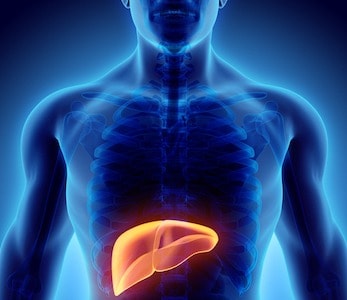
The liver is vital for the breakdown of carbohydrates, fats, and protein. In carb processing, it helps ensure that glucose levels stay balanced.
In the breakdown of proteins, liver cells help convert amino acids from food into substances that can be used as energy. And in fat metabolism, liver cells do basically the same thing – with the help of the gallbladder, it breaks down fat particles into energy.
The liver also has intricate relationships with several other organs. Blood that comes from the digestive system flows through certain areas of the liver bringing nutrients. The liver also works with the kidneys. Ammonia is a byproduct of the breakdown of proteins, carbs, and fats. Liver cells convert this potentially-toxic substance into urea, which is ammonia’s more benign form, which is then transported to the kidneys to be passed out of the body as urine.
And of course, the liver’s function is vitally connected to the gallbladder, which is a small organ located underneath the liver. The gallbladder’s main job is to produce the bile needed for the breakdown of fats.
Liver Health: Liver Function, Fatty Liver & Liver Cancer
Although we now know enough about the liver to understand that it is crucial for the health of the entire body, science is still learning about its connections to specific nutrients, mechanisms, and disease process.
For example, new research is now discovering the link between magnesium deficiency and liver cirrhosis (extensive scarring of the liver) as well as magnesium deficiency and fatty liver disease.
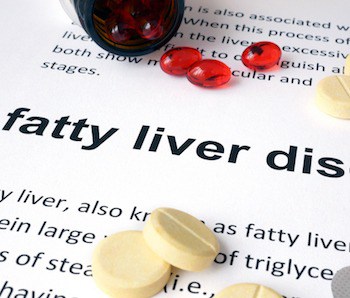
Fatty liver disease, or Hepatic Steatosis, is a condition that is of special concern in this day and age. At one time, fatty liver disease was mostly connected to alcoholism. Over the last decade, however, the number of individuals with non-alcoholic fatty liver disease (NAFLD) has grown exponentially.
NAFLD occurs when the liver is not able to metabolize fats efficiently. According to a 2015 analysis conducted by Thomas Jefferson University,
“there is a worldwide epidemic of non-alcoholic fatty liver disease (NAFLD)…”
According to the American Liver Foundation, roughly 25% of the U.S. population is affected by NAFLD in some way.
Thomas Jefferson researchers call NAFLD a “clinical entity related to metabolic syndrome.” Conventional medicine often connects NAFLD to genetic predisposition as well as obesity and diabetes, although not everyone who is diagnosed with the condition needs to lose weight and/or is struggling with diabetes.
More forward-thinking researchers are now making the connection between NAFLD and environmental and pharmaceutical toxins. Chronic use of certain painkillers as well as the use of certain chemo drugs may be contributing factors for NAFLD.
In addition, a 2017 investigation published in the journal Nature: Scientific Reports made the definitive link between NAFLD and the consumption of GMO foods, especially those that have been sprayed with even the smallest amounts of the pesticide Roundup.
If the connection between chemically produced toxins and NAFLD is correct, then it is no surprise that these chemicals continue to pervade every aspect of our lives. The incidence of not only NAFLD but also cirrhosis, liver damage/failure, and even cancer of the liver will continue to rise as well.
According to the American Cancer Society, the number of liver cancer deaths has increased by three percent every year since 2000. In recent years, over 41,000 Americans have been diagnosed annually with cancer of the liver.
Detox Your Liver, Detox Your Body
In this age of increased toxic load on all levels, including heavy metals, it is imperative that the liver be cleansed on a regular basis. According to both Chinese and Ayurvedic traditions, transitional points of the year (such as the weeks right before the winter and summer solstices) are great times for liver detoxification.
Each of the cleanse modalities listed below can be utilized from one to three weeks. If you are fairly healthy, you should be able to support your liver in these ways while at the same time maintaining a regular schedule.
Although, it may be a good idea to focus on healing as much as possible by keeping extra activities to a minimum during the first few days as your body flushes out extra toxins buried deep within the organs.
Note: If one of your health goals is losing weight and you’ve been unsuccessful, it could be because your body is storing lots of toxins in fat cells. By supporting your main organ of detoxification, you can often give your weight loss efforts a helping hand.
One additional important note. If you have been diagnosed with NAFLD or any other health condition, it would be wise to consult with your health practitioner prior to embarking on any detox diets or other kinds of concentrated cleanses.
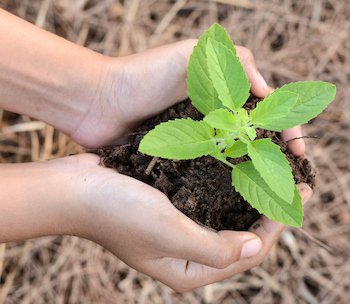
#1: Use Gentle Herbals.
Certain herbs can have a profoundly strengthening effect on the liver. Three such herbs that have been used for centuries are milk thistle, dandelion root, and Holy Basil.
Organic dandelion root and Holy Basil can often be found at health food stores in the form of dietary supplements (or in your own backyard). Milk thistle is often sold in supplement form and can be a great boost for the immune system, as well.
#2: Coffee Enema.
Enemas have been used for centuries by Ayurvedic practitioners and some of today’s top natural health experts say that regular coffee enemas are a “must” for a toxic world.
Administering an enema with organic, pesticide-free coffee can be an instant energy-lifter, and here’s why: blood runs through the liver every three minutes.
Retaining coffee in the bowels for just 15 minutes allows it to seep through the intestinal wall and into the “portal vein” of the liver, where it will stimulate the gallbladder.
Coffee also provides the body with the phytochemicals kahweol and cafestol, which can lower inflammation, activate glutathione production, and encourage cellular detoxification. Coffee enemas have also been shown to stimulate apoptosis, or cancer cell death, in some studies.
#3: Try a liver-cleansing “shot.”
It’s not an injection nor does it have anything to do with tequila (except that you might want to do this the morning after you’ve had “one too many”). A liver-cleansing shot is simple to put together and fairly easy to “down.”
Just combine, in a high-speed blender, one whole organic lemon, cut into pieces (rind and all), 1 Tablespoon extra virgin olive oil, and a pinch of cayenne in 6 ounces of pure water.
Blend at high speed until thoroughly mixed. Then strain and drink. You can also sip this infusion throughout the day for a gentler cleanse; just make sure to wait at least an hour before eating.
As a side note, citrus fruits in general are excellent for liver health. Just be sure if you’re consuming any rind that it’s from washed, organic fruit.
#4: Don’t forget the gallbladder.
The liver-cleansing “shot” mentioned above is great for the gallbladder, too, which is a good thing. In order to really cleanse the liver, you also must take the health of the gallbladder into consideration.
To help your gallbladder prevent painful gallstones, stay away from trans fats and processed foods, and make sure to drink plenty of water. For tasty alternatives to plain water, try our detox water recipes.
7 Ways to Keep Your Liver Happy
Now that you know what to do for a deep liver detox, you can help keep this vital detoxification pathway running smoothly all year long by adding these simple tips and tricks to your everyday routine:
- Get sufficient amounts of vitamins K, D, A, B12, B6, and C, as well as magnesium.
- Drink half your weight in ounces of pure, fresh, filtered water daily (e.g. a 150-lb person would drink 75 oz of water). If you have trouble reaching this number you can also count herbal tea, green tea, and the liquids found in foods such as soup towards your total.
- Go easy on your digestive system by limiting grains and red meat and eat lots of fresh leafy greens and cruciferous vegetables which support liver health.
- Move your body in a way you enjoy; four times per week for a minimum of 30 minutes is ideal.
- Practice stress management techniques such as yoga, meditation, journaling, strolling in nature, skin brushing, soothing baths, and self-massage. Put one of these activities on your to-do list every day!
- Take care of yourself emotionally through journaling, talking to a friend or counselor, or practicing the Emotional Freedom Technique. Holding on to negative emotions, especially trauma, can add to your toxic load.
- Consider going on a deeper cleanse whenever you consistently feel fatigued, tired, bloated, constipated, confused, achy, depressed, anxious, or generally “out of sorts”; these are all signs of toxic overload.
Treat your liver with love, live a healthy lifestyle that supports and strengthens it, and give it some time to deeply clean out the large amounts of toxins we’re exposed to in our modern world every once in a while. Then your liver can do what it is meant to do – help YOU stay vibrant, healthy, and strong!
Organixx Cleanse & Detoxx is a two-step formula that provides a gentle yet powerful full-body detox using organic botanical ingredients. Naturally purge your body of toxins, chemicals, free radicals, heavy metals, waste, as well as bacteria, and pesticides. Easily cleanse your colon, liver, kidneys, lungs, and lymphatic system resulting in increased energy, and better digestion with more nutrient absorption, in addition to improved immunity, mental clarity, and overall health and wellbeing.
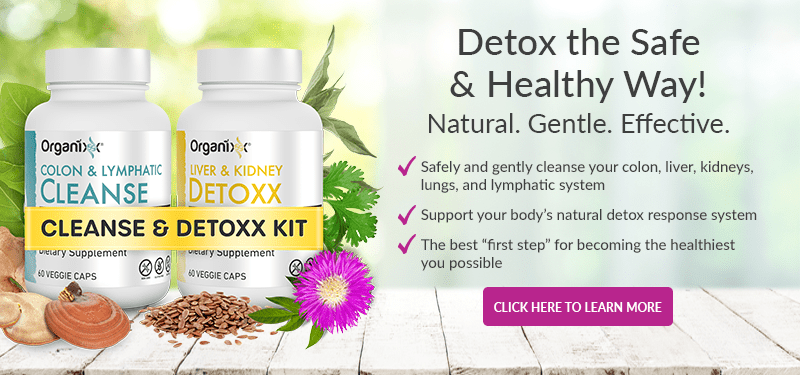
Indulging in sugary foods and beverages is a common occurrence during the holidays, vacations, and other special times of the year. But once these events are over, many people want to know how to stop sugar cravings, detox from sugar, and get their healthy eating plan back on track.
A little in-depth education and a few easy-to-do actions with regard to the many forms of sugar we consume can help us make wise choices with all the sweet foods and beverages – both during holiday times and throughout the year.
The #1 Worst Sugar to Consume
Let’s get the really bad news out of the way first. One of the worst substances you can consume for your health can be summed up in four words: high fructose corn syrup.
Isn’t that just another form of sugar? you may ask. Yes, and then again, definitely no.
When the cravings hit, indulging in too much of any kind of substance that breaks down quickly into glucose is going to tax your body. We will get into that in more detail a little later in this article.
High Fructose Corn Syrup (HFCS), however, is a particularly nasty form of sugar because of the way it is processed and what kinds of products are used to create it.
Other names for HFCS are:
- corn syrup
- maize syrup
- glucose/fructose syrup
- tapioca syrup
- crystalline fructose
- fruit fructose
- added sugars
Whatever name it goes under, the process of making HFCS is basically the same. HFCS is created by allowing certain enzymes to break cornstarch down into tiny molecular substances.
It is cheap to make – in large part because the U.S. Department of Agriculture gives subsidies to farmers who intentionally overproduce commercial corn in order to create it.
High fructose corn syrup is made exclusively from genetically modified (GMO) corn. Here are a few factoids that will help motivate you to stay clear of anything made with HFCS:
- HFCS consumption is linked to autism, Parkinson’s, Alzheimer’s, anxiety/depression, and other brain conditions since it has been known to affect the hypothalamus and other key areas of the brain and endocrine system.
Corn is often genetically modified to be “Roundup Ready” and many experts conclude that Roundup is the main cause for HFCS’s neurotoxicity effects. - Studies also link HFCS with higher cancer risk, in large part because of its GMO connection. A 2008 Chilean study made the link between organophosphate insecticides, hormonal imbalance, and cell mutations.
- As the name implies, HFCS is a form of fructose, which many people may recognize as the form of sugar also found in fruit. The GMO risks withstanding, HFCS may be one of the culprits in the epidemic-sized rise in fatty liver disease amongst non-alcoholics.
Fructose is exclusively processed in the liver. HFCS contains unnaturally high concentrations of fructose minus the fiber and other phytonutrients found in fruit so the liver has to do double-duty to break it down. This means more fat stored in this particular organ, and more risk for disease. - HFCS can also contain unhealthy amounts of mercury, which is derived from the chemical processing used to separate the corn from the husk.
Conventional institutions have claimed that the amount of mercury used in this process would not be enough to cause adverse health effects.
Considering that one out of every ten calories that the average American consumes comes from HFCS and the fact that the damaging effects of mercury toxicity are accumulative, many experts are skeptical of this claim.
Studies have shown that even trace amounts of mercury can cause neurological damage and raise cancer risk.
What About Other Sources of Sugar?
Since the 1970s, American food manufacturers have increasingly used HFCS to sweeten everything from the obvious (cakes, cookies, candy, soda pop, juice) to the obscure (bread, ketchup, and salad dressings to name a few).
As the stats above make clear, it’s a no-brainer that to stay healthy during the holidays and at any other time, it’s best to simply steer clear of the stuff.
Most of us also know about the detrimental effects of artificial sweeteners, so we will not go into that here. But what about plain table sugar, natural cane sugar, and brown sugar? Do these sugar sources also pose a threat?
Unfortunately, the studies are clear about the risks of overindulging in these sweeteners as well. All of them are a form of sucrose, which is a synthetically-derived combination of fructose and glucose. It is hard for the body to process sucrose since it must first separate out the two substances before it can be absorbed by the body.
A 2016 study conducted by MD Anderson Cancer Center was one of the first to look at sucrose’s effect on internal inflammatory mechanisms. Their research has shown that sucrose ingestion had an effect on 12-lipoxygenase enzyme pathways, which can turn on production of detrimental fatty acids. The result is higher inflammation overall.
The MD Anderson study concluded that high consumption of sucrose can lead to higher cancer risk. Other studies have made the same claim between sucrose consumption, immune system depletion, and insulin resistance, which can lead to other diseases, especially diabetes.
How to Stop Sugar Cravings: 6 Strategies
Being exposed to more sugar-laden substances during the holidays may be inevitable, but giving in to the urge to consume them doesn’t have to be. Here are six easy ways to tame your sugar cravings right now:
#1: Boost Your Consumption of Whole Foods.
Upping your consumption of fresh, organic, whole foods such as green leafy vegetables and cruciferous vegetables can not only help your body’s detoxification pathways, but it can also provide extra fiber, vitamins, and minerals.
Protein-rich grass-fed meats and sources of high-quality healthy fat such as avocados and coconut oil can also help curb food cravings.
#2: Consume L-Glutamine.
L-Glutamine is an essential amino acid, meaning that we have to get it from an external source. Glutamine helps with brain function, rebuilds and repairs muscles, fights infections, and is essential for gut health.
It has also been shown to burn fat, heal the gut from stomach ulcers and leaky gut, strengthen the immune system, detox the entire body on a deep level, and balance blood sugar levels.
For thousands of individuals trying to kick the sugar habit, it has also been a real friend. Consistent research has provided proof of its effectiveness in fighting cravings, especially for sugar and alcohol.
#3: Stay Hydrated.
Addictive behaviors, especially regarding sugar, can intensify when we are dehydrated. At the first sign of a sugar craving (or when you are face to face with leftover Christmas cookies), drink a tall glass of water, with lemon if possible.
Be sure to consume at least half your weight (in ounces) in fresh, filtered water each day and start your morning with an 8 oz. glass of lemon water upon arising. Drinking water is extremely helpful for flushing and detoxifying your liver on the day after an indulgence, too.
#4: Heal Your Gut.
Especially if you have consumed a little more sugar or high-carb foods for a day or two, your “gut microbiome” may be moderately to severely out of whack.
Support your digestive system and restore balance by reaching for probiotic and prebiotic foods such as raw cultured vegetables, sauerkraut, low-sugar kombucha, bone broth, raw kefir and yogurt (if you are not dairy intolerant).
Adding probiotic supplements to your daily regimen is a good overall strategy for boosting your gut health, maintaining strong immunity, and cutting cravings as well.
#5: Emotional Work.
Food is tied to so many emotionally-charged moments in our lives. Take the time to reflect post-holiday season and discover the real reason why sugar has such a draw for you.
When you are in crisis or stressed, does eating cake, cookies, ice cream, or potato chips give you comfort? Do you eat these foods when you are experiencing specific emotions such as anger or sadness or when you want to celebrate?
In addition, don’t rule out a physiological addiction to sugar. A 2007 study found that when given the choice between sugary water and cocaine, laboratory rats picked the sugar water every time, whether it was natural (e.g., a piece of fruit), artificial (e.g., HFCS), or fake (e.g., saccharin).
In fact, many food manufacturers use food additives and sweeteners such as HFCS to intentionally create addiction, all in the name of selling more of their product.
You don’t have to be a victim of immoral commercial practices, however. Reach out to others in person or online to get the support you need. And continue to educate yourself about the detrimental effects of sugar on your overall system. You CAN have a healthy relationship with the foods that you enjoy, including the sugary ones!
#6: Be Kind to Yourself if You Happen to Indulge.
Even with a conscious effort to stop eating unhealthy foods and not giving into sugar cravings, the occasional indulgence (or overindulgence) will still often happen. When it does, the best thing to do is to learn from the experience and move on.
Being overcome with guilt and self-criticism will only cause you to stress out more. In the long run, this can cause more inflammation and weight gain. If you go back to the nutritional plan that is best for you after “falling off the wagon,” you can start fresh with little damage done.
Also, just because the holidays (or vacation) are over doesn’t mean you should stop doing enjoyable activities. Due to the “happy hormones” that are produced when seeing new sights, doing exciting things, and visiting with those you love, you may actually find that indulging in moderation when you are enjoying yourself may not cause the weight gain or the detrimental health effects you may expect.
Just be sure to return to your baseline nutritional plan if you do consume a treat and continue to stay hydrated for ongoing detoxification.
Recipe: Dairy-Free, Sugar-Free Peppermint Mocha Latte
 This is a wonderfully refreshing cold-weather treat when served hot or serve over ice in warm weather.
This is a wonderfully refreshing cold-weather treat when served hot or serve over ice in warm weather.
The peppermint soothes the stomach and the cacao powder is high in many essential vitamins and minerals as well as fiber.
The coconut oil provides a boost of healthy fat that can energize and satiate as well.
Here’s what you’ll need:
- 1 cup of organic decaf or caffeinated coffee
- 2 tablespoons raw cacao (not cocoa) powder*
- ½ tablespoon coconut oil
- Pinch of sea salt
- 1 drop supplement grade peppermint essential oil
- Stevia to taste (optional)
Brew coffee. Combine with all other ingredients and blend for about 15 seconds. Sprinkle with additional cacao powder on top if you want and enjoy!
Optional: for straight hot “cocoa,” you can omit the coffee and use either hot coconut milk or almond milk instead.
(*Cacao powder is made from unroasted cocoa beans, which means it has more gut-friendly enzymes and nutrients than its roasted cousin cocoa. Cocoa is what you’ll find on most grocery store shelves and is usually full of added sugar. Raw cacao is available at health food stores and online.)
Organixx Cleanse & Detoxx is a two-step formula that provides a gentle yet powerful full-body detox using organic botanical ingredients. Naturally purge your body of toxins, chemicals, free radicals, heavy metals, waste, as well as bacteria, and pesticides. Easily cleanse your colon, liver, kidneys, lungs, and lymphatic system resulting in increased energy, and better digestion with more nutrient absorption, in addition to improved immunity, mental clarity, and overall health and wellbeing.

Let’s face it. While some people start listening to Christmas music the day after Halloween, others find this kind of behavior, well, just plain annoying. If you are among the millions who tend to get a little overwhelmed with all the hype this time of year and maybe even downright depressed during the holidays, you are definitely not alone.
One survey found that close to half of the respondents said they “dreaded” the festive season.
Here are some quick tips to help you take a breather from all the holiday stress now and focus on a healthier YOU as we enter the holiday season and gear up for a new year.
12 Ways to De-Stress & Get Your REAL Holiday Spirit Back

#1: Take care of YOU first.
Remember that you are the only one who can determine your health needs in any season.
Are you feeling sad because of a recent hardship and need to reach out to a counselor or an understanding friend?
Are you overly stressed and just need some time out? Do you need to write some things down in a journal or go to a Zumba class just to “let it all out?”
This season, practice the art of tuning into your own needs.
#2: Set boundaries with others.
One of the best ways you can beat holiday stress is to practice the art of saying “No.”
Many people feel overwhelmed, anxious, or depressed about spending time with family members that they may not have anything in common with or who may display inappropriate, disrespectful, or disturbing behaviors. Others may stretch themselves too thin doing things for others while neglecting their own needs.
For one week, practice saying NO to favors. Also, consider if excusing yourself from a gathering or two may be a possibility. If you can’t get out of the yearly get-together, set both internal and external boundaries before you go.
It’s okay to not interact with family members that are particularly inappropriate. Instead, choose to connect with someone at the event whom you enjoy or someone you haven’t had a chance to catch up with throughout the year.
#3: Don’t overdo the sugar.
It can be extremely difficult to resist that cheesy mashed potato dish or second helping of pecan pie. However, the fact is that overloading on sugar (especially high fructose corn syrup), alcohol, refined carbs and, for an increasing number of people, gluten and dairy, can intensely tax both the body and mind.
This adds additional stress to an already stressful time of year.
According to an investigation published in the journal Diabetes, Obesity and Metabolism, high fructose corn is more detrimental to brain function than other sugar sources since it can negatively impact the hypothalamus as well as raise cortisol levels. This can turn on inflammatory responses and lower immune function.
#4: Get creative with gift-giving.
In a culture that considers Black Friday another holiday, it’s hard to resist the urge to spend, spend, spend during the holiday season. This is especially true if you are a parent and your kids begin dropping subtle (and not so subtle) hints regarding their holiday wish list in September.
Have a heart-to-heart with your child (or your spouse) if you must, and then get creative with gift-giving this year and avoid financial holiday stress.
#5: Have some fun.
What about a day in the mountains throwing snowballs, or a few hours at the beach making a sand snowman? How about stringing some popcorn to make tree decorations?
Research suggests that play is just as important for adults as it is for kids.

#6: Keep moving.
Exercise is good for your overall health in countless ways one article couldn’t begin to sum up. In addition to lowering stress responses, consider this: new research suggests that regular exercise helps to convert “white” fat cells, a risk factor for cancer, to healthier “brown” fat cells.
A 2012 report published in the journal Nature suggests that heat-generating brown fat can help you burn energy instead of storing it. Other investigations point to regular exercise as a way to prevent “leptin resistance.”
Leptin is a powerful hormone within fat cells that regulates appetite. This holiday season, get creative with how you can fit exercise into an already tight schedule.
Start with something small such as parking at the far end of the mall so you can get a walk in while you shop. Or if you’re really ambitious, fit in a short, intense Tabata workout.
#7: Don’t ruminate but DO reflect on your life.
Several ancient traditions say that winter is a time to go within and reflect. For many, this may seem to be in direct contrast to what our modern society encourages.
Reflection, however, is not the same as rumination. Avoid getting stuck on past regrets by giving yourself a timeframe and an avenue for your reflection.
Write in a journal, make a creative collage, or work on a scrapbook for an hour or two to honor the past year. Then do something fun and self-nourishing that can help you get back into the flow of your life now, in the present moment.

#8: Go on holiday from the media.
A digital detox not only gives your brain a break from electromagnetic fields (EMFs) and your eyes a break from the screen, but it also allows you to form your own concepts of what the holiday season may mean for you.
The media’s job is to sell products, first and foremost. Those “perfect” depictions of holiday shopping sprees and merry families gathered by the fire are designed to make you feel like something is lacking in your life so that you will “spend” your way to happiness.
Ads and posts on Facebook and other social media channels can sometimes make you feel the same way. Don’t buy into the hype; go on a digital detox instead. This time away can give you a fresh perspective even if you abstain for just one day.
#9: Cook up some goodness for yourself and others.
If baking cookies or whipping up the holiday dinner is your job, do something different this year. How can you kick it up a notch so that fresh, wholesome, and healthy holiday recipes are on the menu?
Better yet, consider making it a potluck this year so you don’t have to do all the work. Make sure to specify that dishes be healthy, nutritional, organic, and low on sugars, if possible.
#10: Check your vitamin D levels.
Being in the sun is the best way to get your vitamin D, but you can also consider taking a vitamin D supplement. Moderate sun exposure can provide you with a plethora of other health benefits, too, such as increased nitric oxide production to protect your cardiovascular system. Vitamin D deficiency is very common, especially if you live in a Northern climate or spend a lot of time indoors.
 Seasonal Affective Disorder (SAD) is a depressive condition that affects certain individuals according to the weather, especially during the colder months. Researchers at Athabasca University in Canada found that while only one percent of individuals living in Florida suffer from SAD, close to nine percent of New Englanders deal with the condition.
Seasonal Affective Disorder (SAD) is a depressive condition that affects certain individuals according to the weather, especially during the colder months. Researchers at Athabasca University in Canada found that while only one percent of individuals living in Florida suffer from SAD, close to nine percent of New Englanders deal with the condition.
If you notice that your mood changes significantly during winter, don’t discount that this condition could be a reality for you and that lack of vitamin D may play a role.
The National Institute of Mental Health (NIMH) states that those who are affected most by SAD have lower vitamin D production as well as trouble producing the mood-lifting neurotransmitter serotonin. Young people and women are most susceptible to the condition.
A vitamin D test is easy to obtain from most doctors and laboratories. The standard recommendation is a level of at least 50 nmol/L or 20 ng/mL. However, studies are finding that higher levels of vitamin D may be most effective for cancer prevention and overall hormonal and bone health.
#11: Give yourself a gift.
What if you put yourself on your holiday shopping list? Would you give yourself the gift of an afternoon snuggled up with a good book, a new outfit, a day hiking in the woods, or a relaxing essential oils bath? Give it a try!
Include a gift for yourself in your time or money budget this year and notice how this one act of self-nurturing can help lift your spirits in a big way.
#12: Remember the true “reason for the season.”
Practicing gratitude during this time of year is a great way to switch your mood from “down in the dumps” to a lighter spirit. Believe it or not, practicing gratitude is a great way to detox and heal your body as well.
Studies have shown that practicing gratitude can not only increase happiness levels by 25%, but it can also help you sleep better, help you recover faster after surgery, and lower stress hormones by 23%.
And it’s easy! In a gratitude journal or just in your mind, focus on the simplest things first – the roof over your head, the food in your fridge, the clouds in the sky, the presence of a special friend, family member, or pet in your life. Even being appreciative of the fact that you are breathing can get the gratitude vibe going!
Magnesium deficiency is linked to stress, diabetes, heart disease, osteoporosis, chronic fatigue syndrome, depression, anxiety, trouble sleeping, sore muscles, migraines, and many more debilitating health conditions.
If your body needs magnesium, you want the most beneficial kind your body can actually absorb. Organixx Magnesium 7 gives you seven (7) of the very best, most bioavailable types of elemental magnesium available.
We all have differing opinions on just about everything under the sun. But there is one thing we can likely all agree on: the weather has been downright unpredictable in recent years. So, how in the world can you prepare for the “cold and flu season” this year? One way is to look to plant extracts known as “essential oils” that have been used for centuries to help with everything from a viral infection and sore throat to aches and pains
Many individual essential oils, as well as essential oil blends, have earned their place as safe and effective go-to’s for helping to keep your immune system humming and illness such as the common cold at bay. Conditions such as tension headache can also be helped with essential oils.
Below are 4 “top picks” of essential oils for a headache and other cold & flu symptoms to keep handy this fall and winter. But first, why a trip to the drugstore may not be your best first line of defense…
The Problem With Over-the-Counter Medications for Headache Relief & Cold Symptoms
 At this point, you may be asking, “Why can’t I just pop into my local drugstore for an over-the-counter (OTC) fix when I’m feeling under the weather?”
At this point, you may be asking, “Why can’t I just pop into my local drugstore for an over-the-counter (OTC) fix when I’m feeling under the weather?”
For one thing, all that convenience can come with a heavy price. Those OTCs may help you feel better in the short term, but the long-term effects could be a lower immune system, more inflammation, toxic overload, and liver disease.
It may be true that products such as Tylenol are less habit-forming and somewhat safer than other pain-reducers. However, what most people don’t realize is that (according to Harvard University) acetaminophen (the main ingredient in Tylenol) can also be found in over 30 OTC cold and flu medications, such as Nyquil and Theraflu.
This means that you may be taking more acetaminophen than you realize – especially if you’re taking more than one OTC product at a time. Acetaminophen is broken down in the liver and most of it is expelled through urination. A small amount, however, stays there and is converted into a liver toxin.
Taking too much acetaminophen either at one time or over a long period can result in serious and even fatal liver damage. A 2017 Spanish study also found that too much acetaminophen may affect anti-inflammatory signaling in the liver itself.
Other questionable substances may be lurking in your cold medication as well. These include mercury-containing high fructose corn syrup (made from GMO corn), sorbitol, artificial flavors, colors, fragrances, and parabens, a hormone disruptor banned in the European Union.
Essential Oils for Colds: Key Oils to Keep You Healthy This Season
A healthier option is to consider essential oils for sore throat and other symptoms, especially when you first feel a cold or flu coming on. There are dozens of essential oils as well as oil blends that can be used to help boost immunity and calm symptoms such as a nagging cough.
Here are some of the best individual essential oils for soothing, comforting relief:
#1 – Lemon.
Health experts (and common sense) say that fighting colds and flus begins with the immune system. A strong immune system will ward off the overabundance of pathogens flying into your personal space, making you less prone to “catching” something in the first place and being able to bounce back quicker if you do get sick.
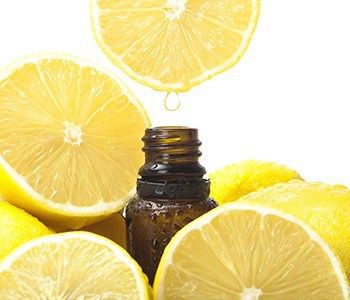 Lemon essential oil, which comes from the cold-pressed rinds of the lemon fruit, is a powerhouse of immune-boosting compounds.
Lemon essential oil, which comes from the cold-pressed rinds of the lemon fruit, is a powerhouse of immune-boosting compounds.
The main source of lemon’s potential healing force comes from the monoterpene limonene, a phytonutrient (plant nutrient) that helps to detoxify many key organs, including the kidneys, liver, and lymphatic system. It has also been found to be an anti-inflammatory, so much so that dozens of studies have been devoted to its role as a disease preventer.
Lemon is also great for the gut, so it can be a good friend if you are unfortunate enough to catch a stomach flu or eat “the wrong thing” at the annual holiday party. It has also been known to ease gastric upset and lower inflammation in the digestive tract.
Finally, if you find yourself having the “winter blues,” studies have found that limonene found in lemon essential oil can be a significant mood booster.
Other essential oils that help support a healthy immune response include cinnamon, grapefruit, and clove.
Try This: Want to be one step ahead of all those nasty cold and flu viruses this season? Simply add one drop of lemon essential oil to about 8 oz. of filtered water and drink first thing in the morning.
#2 – Oregano.
Got some boot-wearing foot fungus coming on? Oil of oregano contains two specific compounds – carvacrol and thymol – that studies have shown are both anti-fungal and anti-bacterial.
The phytonutrient carvacrol, in particular, has been mentioned in over 500 National Institutes of Health-documented studies for its usefulness against not only bacterial and fungal infections but also viruses, parasites, candida, allergies, and general inflammation.
Consider this: it can take up to 1,000 pounds of oregano leaves to produce one pound of oregano oil. That’s quite a punch for your unwelcome bacterial “friends” wanting to hitch a ride on your feet, your throat, your gut, or anywhere else you may find those nasty pathogens multiplying and making your day miserable.
Some studies have even demonstrated oregano’s effectiveness for bacterial infections when compared to traditional antibiotics. Other anti-bacterial and anti-fungal essential oils include melaleuca (tea tree oil), geranium, lemongrass, peppermint, and rosemary oil.
Try This: Put a few drops of oregano oil in a carrier oil such as coconut oil, jojoba, or olive oil and rub on your feet at night. Not only will the foot rub be a nice way to calm down for a healing sleep, but traditional medicine (as well as new scientific inquiry) suggests that “transdermal application” (applying topically to the skin) of some substances may have the same potency as oral ingesting.
Take Note: Oregano oil is a “hot” oil. Because of its potency, some experts recommend taking oil of oregano for no more than up to two weeks at a time. Always consult with a qualified health practitioner first before using oils internally, especially pregnant women or anyone with health concerns.
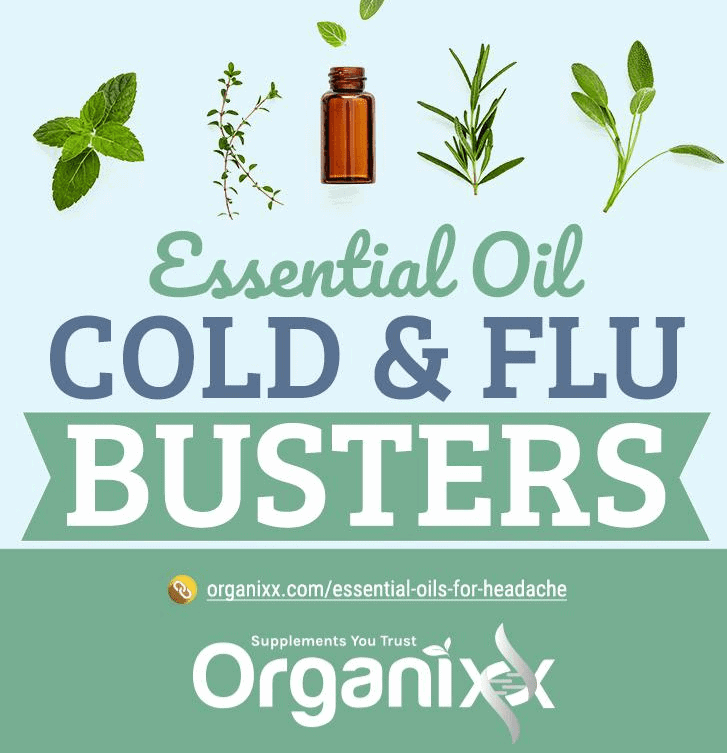
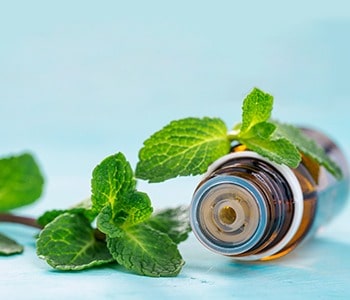
#3 – Peppermint.
Tried and true peppermint is perhaps the best-known and most loved essential oil out there. And when it comes to colds and flus, this is for good reason! Like oregano, peppermint also has been found to have anti-bacterial as well as anti-viral properties.
In fact, oil of peppermint can destroy airborne germs, helping to keep the air around you a “flu-safe zone” if used in a diffuser. Peppermint is also a decongestant and an expectorant, making it a great oil to have in your toolbox for head colds and respiratory infections.
Peppermint essential oil can also help reduce the headaches that often accompany stuffy sinuses. Finally, peppermint can make you sweat, which speeds up blood flow and assists in gently moving a fever out of the body.
Eucalyptus oil is another wonderful essential oil to have in your toolbox for sinus-related colds and flus.
Try This: For a simple way to decongest and lift a “cold-induced” fog, simply place one or two drops of essential oil in the middle of one palm (2 drops peppermint or 1 drop peppermint + 1 drop eucalyptus). Rub your palms together then open them and place them close to your nose. Breathe in and feel the instant relief! In addition, a drop or two of peppermint oil in some carrier oil can be gently rubbed on the temples or dabbed on with a clean cotton ball (avoiding the eyes) to reduce headaches. By the way, peppermint is also considered one of the best essential oils for migraines.
Take note: Whenever you’re trying an essential oil for the first time, always test for sensitivity first. Start by smelling an oil to see if the oil seems pleasing to you. If all is well, mix a drop with several drops of carrier oil, apply to your wrist, and watch for any type of reaction (i.e. redness or itching). If no reaction occurs, then you can move on to trying the oil with a carrier oil on other parts of the body.
#4 – Essential Oil Blends.
The sky is the limit as to what kinds of essential oils you may want to blend together to make a cold and flu-busting formula that is just right for your body. Blending oils is a great way to access the synergistic effect of plant phytonutrients that can work together holistically to help you stay vibrant and healthy!
Try This: Even though different people respond to essential oils and essential oil blends in different ways (see the “Take note” above), there are some time-tested essential oils that do especially well together to synergistically help you fight whatever might be “going around.”
One of the best combinations for a soothing yet powerful germ-buster is a mix of oregano (mentioned above), clove, cinnamon, ginger, and thyme to help your body transition into winter and your mind gracefully prepare for the busy time to come.
If you’ve got strep throat or any kind of sore throat, try 1-2 drops in some warm water and gargle. (To help ensure the water has no harmful bacteria, use boiling water that you’ve allowed time to cool.)
The warming and immune-boosting qualities of both ginger and cinnamon are perfect for supporting your digestive, immune, and circulatory systems. And because of the antibacterial properties of oregano, clove oil, and thyme, you can use this blend in DIY toothpaste and mouthwash recipes as well.
Protect Yourself with Essential Oils
Let’s face it: no one wants to get sick, no matter what the season. More than any other time, however, during the holidays is when you are most at risk for cold and flu. It is also the time of year when you want to feel your best!
Winter colds and flus are not inevitable with just a little preparation. Keep sugar consumption and stress as low as possible and use key essential oils (the ones listed above and others like lavender essential oil) to help get you through the tough times.
The powerhouse trio of herbs in Magi-Complexx Essential Oil provides the strongest, most synergistic healing effect, helping sufferers of arthritis pain, constant muscle aches and pains, neuropathy, systemic inflammation, slowed wound healing, circulatory challenges, as well as skin irritations like eczema, psoriasis, and acne.
The official first day of winter is only days away and the holiday season is in full swing. That means food… lots and lots of it in the break room at work, on grocery store displays, at your favorite diner, and prepared especially for you by relatives and friends during holiday visits.
If you’re like most people, you gobble it all up because (let’s face it) as soon as the weather turns, your munchie-factor goes through the roof. Unfortunately, so does that winter weight gain.
So, what gives? Is our tendency to eat more in colder weather just a product of social conditioning or is our body trying to tell us something?
What Science Says About Fall & Winter Weight Gain
 According to a study conducted by the University of Georgia in the early 1990s, human beings as a whole tend to eat more and feel hungrier as the weather turns from warm to cool.
According to a study conducted by the University of Georgia in the early 1990s, human beings as a whole tend to eat more and feel hungrier as the weather turns from warm to cool.
“The results suggest that even with modern heating and lighting, seasonal rhythmicity of food intake persists in humans and is a major influence on eating that may act by suppressing satiety mechanisms,” say the U of G researchers.
They found that individuals eat an average of 200 more calories a day in the beginning days of autumn when days start to get colder and darker. They found that hearty appetites taper off, however, in the winter and spring.
“We are driven by things implanted in our brain a long, long time ago,” says University of Massachusetts cardiologist Ira Ockene in a recent NPR interview. He has long been fascinated with how people eat with the seasons and why.
Ockene says extra hunger has to do with the availability of light as well as cold. He compares what we do to how chipmunks behave when they store up all those chestnuts for the coming long, cold winter. Lack of light prompts us, on a subconscious level, to eat more food and also to eat faster.
Another big reason for the body’s desire for extra calories as summer turns to fall is physiological. Scientists have discovered that the body’s constant search for warmth during the cold months, seen in the act of shivering, takes a lot more energy than one would expect. In fact, some estimates claim that just 15 minutes of shivering can burn about 100 calories and produce effects in the body that are similar to exercising.
A recent investigation conducted by Australia’s Garvan Institute of Medical Research found that shivering can stimulate the conversion of “white fat” to “brown fat” in the body.
While white fat is known as “energy-storing” fat, brown fat is energy-burning. This same conversion has been known to happen when a person exercises, leading some to propose that this mechanism could be used to fight diabetes and obesity. Controlled hypothermia, also known as cryotherapy (polar plunge anyone?), may do the same thing.
We would never suggest standing out in the snow in your shorts to get out of exercising. Still, even if a person’s teeth are not chattering, just a slight drop in temperature can kick in something called “nonshivering thermogenesis (NST).” This is when the body is not twitching because of the cold, but is working just as hard internally to keep warm.
What’s the point of all this when it comes to how we eat? Simply put: more energy expended equals a greater need for replenishment, i.e. more protein-rich and often fat-rich food.
Lessons From Ayurvedic Medicine: Fuel Your “Inner Flame” by Eating With the Seasons
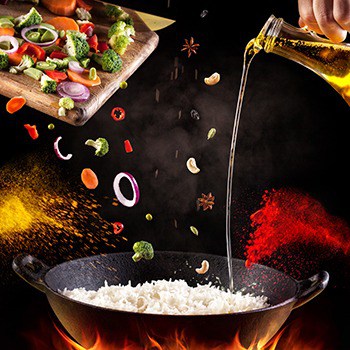 What kind of food is best to consume as the days grow shorter and colder? For many people, the extra calories come from additional carbs in the form of sugary treats. But is that really the healthiest way to prepare for the long, cold winter?
What kind of food is best to consume as the days grow shorter and colder? For many people, the extra calories come from additional carbs in the form of sugary treats. But is that really the healthiest way to prepare for the long, cold winter?
The answer might come from the wisdom of many ancient healing traditions that have long used the turning of the seasons to guide their eating practices.
One such ancient healing tradition is Ayurveda. Practitioners of this ancient form of medicine have long held to the concept that food is medicine. In Ayurveda, the most important factor to consider outside of eating for your particular dosha (vatta, pitta, or kapha) is if the food consumed also helps to cultivate your “inner agni,” or “inner flame.”
For Ayurvedic practitioners, the agni is life force, so the less we have of it, the less “life force” we have within us. In Chinese medicine, this life force energy is known as “Chi.”
Following Ayurvedic food practices means considering the following factors, regardless of what time of the year it is:
- how the food is prepared
- where it comes from
- how fresh it is
- the flavors it holds
- the colors it has
- how much we eat
- what kind of mental state we are in while eating
- what kind of mental and spiritual state we are in after eating it
Eating with the seasons is called Ayurvedic Ritucharya in the Ayurveda tradition. In order for our food to cultivate the best agni, eating with the flow of the regional geography and natural elements where we live is vital.
As a general rule, Ayurveda recommends eating cooling foods in summer and early fall and then, as the weather turns colder, focusing on foods that gently warm the body.
A partial list of foods that are considered to cultivate warmth include:
- “spicy” teas like ginger or chai
- steamed vegetables (as opposed to raw ones)
- healthy broths, soups, and stews
- warming spices such as turmeric, cinnamon, clove, cardamom, nutmeg, ginger, and ground chilies
- fruits like apricots, cherries, grapefruit, pineapple, and lemon
- vegetables such as artichoke, Brussels sprouts, mushrooms, cooked spinach, turnips and winter squash, onion and olives
- nuts like almonds with skin, cashews, macadamia nuts, and pine nuts
- legumes like lentils, miso, kidney beans, and navy beans
- grains such as millet, brown rice, and buckwheat
- organic, hormone-free eggs
- dairy products such as organic butter, sour cream, and plain yogurt
For all seasons, Ayurveda experts say to prepare and eat plenty of organic foods that represent all colors. Nutrients and phytochemicals that reside in fresh fruits and vegetables help to detox the body as well. Plus, drinking plenty of filtered, room-temperature water during the cool months aids in flushing those toxins right out of the body!

Can You Eat Meat and Still Eat Ayurvedic?
Although this may not have been an option when Ayurveda first came to the West about 100 years ago, because of the success so many individuals have had with anti-inflammatory, low-carb diets such as Paleo and ketogenic, modern Ayurvedic practitioners like Dr. Akil Palanisamy are getting creative in developing “paleovedic” eating plans for their omnivore clients.
Options for good paleo-focused foods to consume for the colder months might include:
- bone broth
- organic, grass-fed beef
- antibiotic- and hormone-free chicken
- organic lamb
- mercury-free fish and shrimp
Let Fall and Winter Be a Time of Reflection, Rejuvenation & Connection
Many ancient traditions see the cold-weather months as a time to reflect, renew, and rejuvenate in preparation for the warmer months when people tend to be more active.
This just makes logical sense, especially if you look to the natural world. Think of the bear who builds his body up for that deep, winter-long snooze; that sleep is a time for the bear to rejuvenate its body.
Unfortunately, in our human world, we cannot sleep the winter months away, but we can choose to slow the tempo of our lives down a little bit by consciously choosing what we eat and by eating mindfully, keeping in mind nourishing and detoxifying our body.
In addition, eating with the seasons where you live also means learning about what foods grow in your vicinity, and at what time of year. Always try to purchase organic locally-grown produce and regionally-raised animal products whenever you can, and don’t be afraid to try heirloom varieties of vegetables and fruits.
In this way, not only are you learning about the geography of your region, but you’re also supporting seed diversity and preservation and your local economy to boot!


